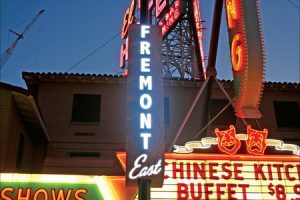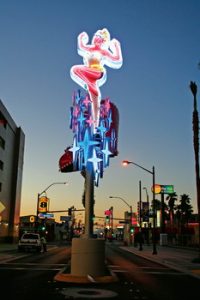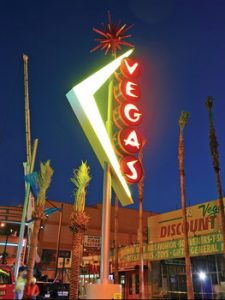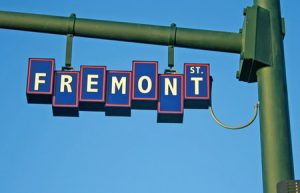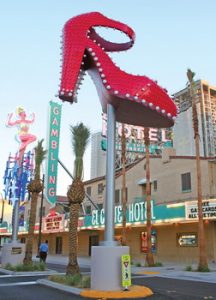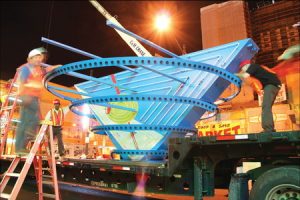Electric Signs
Fluoresco Does Fremont
More from the revamping of a Vegas entertainment district.
Published
16 years agoon
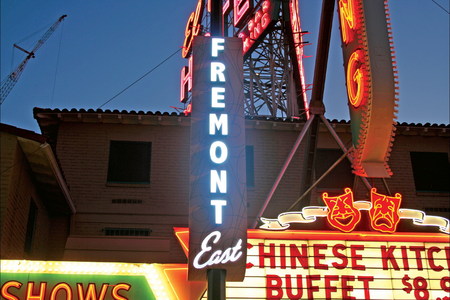
Read Part One
Viva Oscar and Elvis!
The four themed streetscapes sit on the east and west traffic medians, which straddle the crosswalks midway on the district’s first two blocks. “Oscar’s Martini” and “Viva Vegas” are paired at one crosswalk, while the “Lucky Lady” and “Ruby Slipper” brighten the other.
All four poles comprise steel pipes on base plates, which were painted metallic silver (they used Matthews’ acrylic polyurethane on all painted surfaces). Onsite, Fluoresco used a computer-controlled plasma cutter and torch table to cut some of the 1½-in.-thick steel base plates to size. Using hand torches, fabricators cut the pipes to length.
Canted on a stainless-steel pole at 29° facing south, as any good martini glass should be, Oscar’s Martini (named after Las Vegas mayor Oscar B. Goodman and his favorite cocktail [see sidebar]) resides approximately 38 ft. above the street. The “glass” measures 21 ft. high and 19 ft. wide (a dream libation, indeed).
The glass comprises two sets of elements: a blue and white, aluminum cabinet with a red swizzle stick and a green pimento olive. A set of upper and lower steel hoops extends from the cabinet to the pole.
AdvertisementFluoresco created the martini glass and the other project shapes on one of our MultiCam CNC routing table. Because of the large shapes, fabricators used the company’s largest router table (10 x 20 ft.) and oversized, 6 x 20-ft., aluminum. Fabricators created the interior cabinet framing from steel or aluminum cut to size on radial-arm saws, band saws or a cold saw. They completed the framing with portable MIG or TIG welders.
RGB LEDs were mounted on aluminum facing attached outside the rolled 3 x 3 x ¼-in., steel-angle hoops. The cabinet features exposed neon that matches the painted background’s colors.
The martini’s LED pixels comprise 692 Smart Clusters, or pucks, from LED Power (Irvine, CA). Attached to conceal both sets of hoops, the pucks include nine RGB diodes. Each puck has a smart computer chip that controls the diodes independently.
Using digital, multiplexing (sending several signals over the same line to adjust duration or frequency), lighting controllers inside the cabinet, Fluoresco programmed each Smart Cluster puck independently to change color or intensity, or fade. According to Mackin, the controls can make the glass “fill up,” and spokes of light rotate around the glass shape. Fluoresco provided the city with the software to preprogram or create different sequences. Each cycle runs for nearly 20 minutes.
One installation challenge almost sent Fluoresco to a Fremont Street bar. The martini was too large to ship on its pole or with all hoops attached. The base and stem of the martini glass, as well as the prewired LED pucks and base hoops, arrived on the support pole, but the top and upper hoops arrived disassembled.
After Fluoresco’s team set the support pole, they bolted the glass’s top and welded it to the pole. Then, fabricators bolted on the support angles and the corresponding hoops and installed the neon and wiring.
AdvertisementCreating the animation and flashing sequences also required additional time, wiring and components. Mackin said, “Because the olive needs to illuminate after the gin, each element required a separate, animator-controlled transformer.”
“Viva Vegas” recalls the 1964 Elvis Presley movie, Viva Las Vegas. The sign integrates the circa-1950s motif of integrating a chevron arrow into the marquee. This yellow-chevron cabinet entailed four bolted pieces welded to the pylon onsite. Fluoresco illuminated this with 15mm, yellow neon. Each of the five, open-channel letters rests in a red and reflex-blue disk cabinet attached to the pylon with 4-in.-wide, horizontal pipes. The illumination features exposed, 15mm, clear-red neon on both sides.
Of showgirls and shoes
A block east, the “Lucky Lady Dancing Girl” celebrates the city’s superlative past and present entertainment venues. The landmark Stardust marquee inspired the enveloping stars, Lutz said.
Measuring approximately 33 ft. tall, the multicolored, bikinied retro-woman features a large fabricated aluminum cabinet with elaborate neon. The image includes 10 painted colors, five neon hues and amber, scintillating Tokistar LED diodes on her costume.
AdvertisementMackin said this required complex construction, especially to fit the transformers and wiring inside the cabinet. Still, the 34 aluminum stars that wrap 360° around the pole below the sign cabinet posed the greatest obstacle. These project from the support pole via 1½- and 2-in. steel-pipe stubs and flash independently of the figure’s modules.
Four different neon colors glow through the acrylic faces. This required Fluoresco to cleverly incorporate a perimeter cabinet integral to the structure. To facilitate the process, the company shipped the cabinet and pole with pre-wired pipe stubs from Tucson.
Fluoresco again used SolidWorks 3-D software to ensure the stars didn’t compete with each other or the “Lucky Lady” sign cabinet. The team developed a flat, paper pattern that, when wrapped and taped to the vertical support pole, would locate each projecting pipe. At these locations, fabricators used a magnetic drill press with a hole-saw bit (along with some custom brackets) to drill through the support pipe at each of the 34 locations. After having drilled the holes, they inserted the pipe stubs for the stars through the hole and welded them in place.
Facing the “Lady” from across the median, the approximately 35-ft.-high Ruby Slipper, a 3-D, fiberglass shoe rotates and shines brilliantly, thanks to 951 incandescent lamps.
The slipper pays homage to the famous Silver Slipper Resort and Casino, which was built in 1950. The rotating silver slipper atop its roof remained a Vegas icon until the resort’s 1988 demolition.
Fabrication challenged Fluoresco designers and fabricators. “We debated aluminum fabrication over fiberglass and decided fiberglass would be lighter and would yield better compound curves than aluminum,” Mackin said.
Fitting the rotator and the incandescent breaker panel within the shoe’s shape required further design and installation strategy. Fluoresco set the pole days before the fiberglass shoe arrived. The slipper arrived in two pieces – the heel and the remainder. “We installed the shoe on the support pole and then bolted on the heel,” Mackin recalled. “After the heel was installed, the shoe was wired into the primary power, and all lamps were installed.”
Identify yourself!
Six pylon signs hang on both sides of Fremont from existing, aggregate streetlight poles roughly 20 ft. above the street. These vertical identifiers face toward Fremont Street. The cabinets feature painted graphic lines, while the aluminum, open-channel letters that identify “Fremont” feature white, painted faces with 10mm EGL white neon; the returns shine with reflex blue.
Fluoresco created radii around the sign cabinets to envelop the supporting light pole. Below the extruded “Fremont,” an LED-lit script that reads “East” also pushes through and projects in front of the rolled face.
At first go, however, the radius was too tight to rout the “East” out of a flat sheet of acrylic, and, because the typestyle required a connected script, Fluoresco couldn’t route individual letters and push them through separately. To solve the problem, fabricators created a custom wood form at the radius and vacuumformed a flat sheet of acrylic into the radius shape with embossed “East” copy.
Six illuminated Fremont Street signs and five cross-street markers identify the district’s roads. Fluoresco mounted these aluminum signs beneath the mast arm of existing traffic signal poles. The letters alternately offset horizontally, above and below, and are painted reflex blue and orange. Each is illuminated with a 10½-in. Sylvania Dulux “L”-shaped fluorescent lamp and ballast.
Finally, the newly widened sidewalks along the two blocks of Fremont St. feature 18 embedded, diamond- or oval-shaped, crosswalk medallions. The medallions, bright with ambient light, are embedded flush into district sidewalks. The centered text, against recessed backgrounds, is complemented by etched borders. High-lighted with stars, the plaques commemorate the city’s 1905 founding and such seminal events as Nevada’s 1931 legalization of gambling and the Hoover Dam groundbreaking.
The city unveiled the newly minted signage at an August 24 ceremony where Fluoresco employees flipped the switch to light the neon for the first time.
“The Fremont East Project has been an important step towards Fluoresco’s efforts to attract large-scale, creative projects,” Ladd Kleiman, the company’s president, said. “For our craftsmen, this has been a fun and glamorous project. It is an art form, in addition to becoming a landmark for visitors to Las Vegas.”

SPONSORED VIDEO
Introducing the Sign Industry Podcast
The Sign Industry Podcast is a platform for every sign person out there — from the old-timers who bent neon and hand-lettered boats to those venturing into new technologies — we want to get their stories out for everyone to hear. Come join us and listen to stories, learn tricks or techniques, and get insights of what’s to come. We are the world’s second oldest profession. The folks who started the world’s oldest profession needed a sign.
You may like

American Sign Museum Names New Executive Director

3 Things Print Pros Must Do to Build Stronger Relationships in the Interiors Market

Graphics Turn an Eyesore Cooler Into a Showpiece Promo in Historic Plaza
Subscribe

Bulletins
Get the most important news and business ideas from Signs of the Times magazine's news bulletin.
Most Popular
-

 Tip Sheet1 week ago
Tip Sheet1 week agoAlways Brand Yourself and Wear Fewer Hats — Two of April’s Sign Tips
-

 Ask Signs of the Times3 days ago
Ask Signs of the Times3 days agoWhy Are Signs from Canva so Overloaded and Similar?
-

 Photo Gallery1 day ago
Photo Gallery1 day ago30 Snapshots of the 2024 ISA Sign Expo
-

 Real Deal1 week ago
Real Deal1 week agoA Woman Sign Company Owner Confronts a Sexist Wholesaler
-

 Benchmarks6 days ago
Benchmarks6 days ago6 Sports Venue Signs Deserving a Standing Ovation
-

 Editor's Note2 weeks ago
Editor's Note2 weeks agoWhy We Still Need the Women in Signs Award
-

 Women in Signs1 week ago
Women in Signs1 week ago2024 Women in Signs: Megan Bradley
-

 Photo Gallery1 week ago
Photo Gallery1 week ago21 Larry Albright Plasma Globes, Crackle Tubes and More
